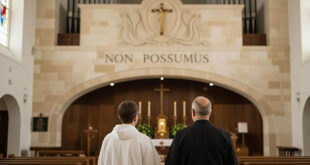When we talk about the role of the Virgin Mary in redemption, we encounter a topic of great theological depth and devotion. The Catholic Church has always recognized her unique role in the history of salvation, but the question often arises: Is Mary “Co-Redemptrix” with Christ, or is she simply a “coredemptrix” in a more limited sense?
This article seeks to explore this question with theological rigor while also offering a spiritual guide to understanding how Mary’s example can inspire us in our Christian life.
1. Mary in God’s Plan: Predestined for Redemption
From the moment of the Annunciation, Mary was chosen for a central role in the mystery of redemption. When the angel Gabriel announced:
“Rejoice, full of grace, the Lord is with you” (Luke 1:28),
it was revealed that God had prepared her soul for a unique mission: to be the Mother of the Redeemer. Her “yes” at the Incarnation was not just a passive acceptance but a total surrender to God’s will—an act of collaboration in the salvation of the world.
St. Louis de Montfort expresses this clearly in his “True Devotion to the Blessed Virgin”, stating that God chose to come into the world through Mary, and thus also desires that we go to Him through her.
2. What Does “Coredemptrix” Mean?
The term “coredemptrix” consists of the prefix “co-” meaning “with” and “redemptrix,” referring to the work of redemption. The word does not imply equality with Christ but a unique and subordinate participation in His redemptive work.
Pope St. John Paul II used this term on several occasions, affirming that Mary, through her suffering alongside Christ on the Cross, participated in a special way in the work of redemption. In the encyclical “Salvifici Doloris” (1984), the Pope explains that Mary, “through her maternal suffering, uniquely participated in the Redemption of humanity.”
Does This Mean That Mary Is “Co-Redemptrix” on Equal Footing with Christ?
No. Christ is the only Redeemer, the sole mediator between God and humanity (1 Timothy 2:5). However, just as St. Paul says:
“I complete in my flesh what is lacking in Christ’s afflictions, for the sake of His Body, which is the Church” (Colossians 1:24),
Christians can participate in the work of redemption. Mary did so in the most supreme way.
3. Why Do Some Oppose the Title of “Co-Redemptrix”?
Despite the support of many saints and theologians, the Church has not officially proclaimed the dogma of “Coredemption.” Why?
- Fear of theological confusion: The Church has always been careful in expressing the relationship between Mary and Christ to avoid misinterpretations.
- Ecumenical dialogue: In the context of dialogue with Protestants, the use of the title “Co-Redemptrix” could be misinterpreted as if Mary were a redeemer separate from Christ.
Pope Francis has avoided using this term, stating that Mary is “Mother, not a goddess, nor a co-redemptrix.” However, he continues to promote her role as mediatrix and advocate.
4. Practical Application: How to Live Mary’s Example?
While the debate over her title continues, the most important thing for the faithful is to understand how we can imitate Mary in our spiritual life.
1. Total Surrender to God
Mary is the perfect model of surrender to God’s will. Her “Let it be done to me” (Luke 1:38) teaches us to trust in God even in moments of uncertainty.
2. Participation in Christ’s Cross
Just as Mary stood at the foot of the Cross (John 19:25), we are also called to carry our own crosses and offer them for the salvation of the world.
3. Mediation in the Lives of Others
Mary intercedes for us, as she did at the Wedding at Cana (John 2:1-11). We, too, can be instruments of God to lead others to Christ.
Conclusion: Mary, Our Mother and Coredemptrix in Love
Regardless of whether the Church proclaims the title of “Co-Redemptrix” or not, what is certain is that Mary had a unique role in redemption and continues to guide us to Christ.
More than just a theological debate, her example invites us to live with faith, love, and total surrender to God. In our daily lives, we can imitate her humility and trust in the Lord, becoming collaborators in redemption through our actions and prayers.
Mary, our Mother, help us to live as true disciples of your Son. Amen.






